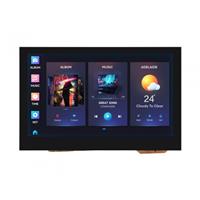
|
KiCADKicad
|
Simple, ultra high performance condenser microphone circuit
See https://github.com/Spirit532/studio_mic
I needed a good quality microphone, but all of the options available were either a bit pricy or just not really good in performance, so I decided to build my own.
The microphone build uses a clone RK12 capsule($40-50 on Aliexpress/Ebay/etc), a U87 donor body($15-30, also there), and a custom preamp board($20-30).
The board is very simple, yet high performance - it uses a dual FET input opamp in a single package to both convert the capsule's impedance and provide a differential signal, while the bias is provided by a slightly cursed hex schmitt trigger inverter charge pump.
With the setup pictured below, the results are, to the non-audiophool ear, perfect. There is practically no self-noise due to the simplicity of the circuit and performance of the chosen opamp, plenty of dynamic range, and no signal distortion/"colortaion". You get exactly what the capsule sees on the XLR connector.
Notes about component choice
- You can use pretty much any FET input opamp, however you must pay close attention to the quiescent current. This circuit uses a fairly high impedance power path, and the phantom power standard can't provide much current in the first place. Total power consumption of the two opamps should be no more than ~7-8mA(3.5-4mA per).
- Same goes for the hex inverter in terms of power consumption, but otherwise anything will do. You can substitute the part with any 40106 clone of similar functionality.
- Take care to purchase high voltage rated capacitors where specified - this is important! Ceramic capacitors lose capacitance at higher voltages, so X7R class caps rated at 100V or more are preferred(this won't explicitly solve derating, but it will help). All values are readily available in 0805 size, so it's not an issue.
- Choose NP0/C0G capacitors for ceramics if your budget allows. They'll improve performance a little bit, but not by a whole lot. (this will solve derating, but at significant cost)
The design is licensed under the MIT license. If you want to build it, go ahead. If you want to sell it, also go ahead, but just mention this page or something. Pretty much none of this is really original and has been done dozens of times(i.e. DJJules/Sound Sleuth over at Instructables, whose circuit I took inspiration from), I just put my own twist on it.
Simple, ultra high performance condenser microphone circuit
*PCBWay community is a sharing platform. We are not responsible for any design issues and parameter issues (board thickness, surface finish, etc.) you choose.

Raspberry Pi 5 7 Inch Touch Screen IPS 1024x600 HD LCD HDMI-compatible Display for RPI 4B 3B+ OPI 5 AIDA64 PC Secondary Screen(Without Speaker)
BUY NOW
ESP32-S3 4.3inch Capacitive Touch Display Development Board, 800×480, 5-point Touch, 32-bit LX7 Dual-core Processor
BUY NOW
Raspberry Pi 5 7 Inch Touch Screen IPS 1024x600 HD LCD HDMI-compatible Display for RPI 4B 3B+ OPI 5 AIDA64 PC Secondary Screen(Without Speaker)
BUY NOW- Comments(9)
- Likes(16)
-
 Engineer
Mar 19,2025
Engineer
Mar 19,2025
-
 Engineer
Feb 11,2025
Engineer
Feb 11,2025
-
 Robert Rafai
Dec 05,2024
Robert Rafai
Dec 05,2024
-
 Engineer
Nov 03,2024
Engineer
Nov 03,2024
-
 Roman Yanchuk
Sep 16,2024
Roman Yanchuk
Sep 16,2024
-
 Engineer
Jul 27,2024
Engineer
Jul 27,2024
-
 Engineer
Mar 10,2024
Engineer
Mar 10,2024
-
 Mitko Petrovik
Feb 23,2024
Mitko Petrovik
Feb 23,2024
-
 Marian Ungur
Jan 24,2024
Marian Ungur
Jan 24,2024
-
 aidan Smith
Nov 09,2023
aidan Smith
Nov 09,2023
-
 Semih Burak Yorgancı
Sep 04,2023
Semih Burak Yorgancı
Sep 04,2023
-
 Matthias Steinbrecher
Aug 29,2023
Matthias Steinbrecher
Aug 29,2023
-
 saulius659
Apr 17,2023
saulius659
Apr 17,2023
-
 Mariusz Sobolewski
Apr 07,2023
Mariusz Sobolewski
Apr 07,2023
-
 Tobias Pfeiffer
Mar 26,2023
Tobias Pfeiffer
Mar 26,2023
-
 Andrey Andrey T.
Mar 18,2023
Andrey Andrey T.
Mar 18,2023
- 0 USER VOTES
- YOUR VOTE 0.00 0.00
- 1
- 2
- 3
- 4
- 5
- 6
- 7
- 8
- 9
- 10
- 1
- 2
- 3
- 4
- 5
- 6
- 7
- 8
- 9
- 10
- 1
- 2
- 3
- 4
- 5
- 6
- 7
- 8
- 9
- 10
- 1
- 2
- 3
- 4
- 5
- 6
- 7
- 8
- 9
- 10
 More by Andrey Andrey T.
More by Andrey Andrey T.
-
-
Commodore 64 1541-II 1581 Floppy Disk Drive C64 Power Supply Unit USB-C 5V 12V DIN connector 5.25
258 1 3 -
Easy to print simple stacking organizer with drawers
105 0 0 -
-
-
-
-
-
-
Modifying a Hotplate to a Reflow Solder Station
1190 1 6 -
MPL3115A2 Barometric Pressure, Altitude, and Temperature Sensor
670 0 1 -













































84V, see schematic.
Thank you, I see it now. And would there be a simple way to reduce the voltage across the capsule? For example 60V/72V instead of 84V. As I understand, too high of a polarization voltage can cause the capsule diaphragm to get sucked in to the backplate
You can lower the bias voltage by sequentially removing C16&D7 and shorting the nodes labelled 72V and 60V, then doing the same for C15&D6, 72 -> 48V if it's not enough. Inverter nodes can be skipped.
Thank you again for the explanation, very helpful. Will following these steps provide the same performance, just at lower bias voltage? I'm not an expert in electronics so I don't fully understand what the rest of components of the circuit are doing.
Yes, the bias supply is completely independent.
thank you again, will go for it!